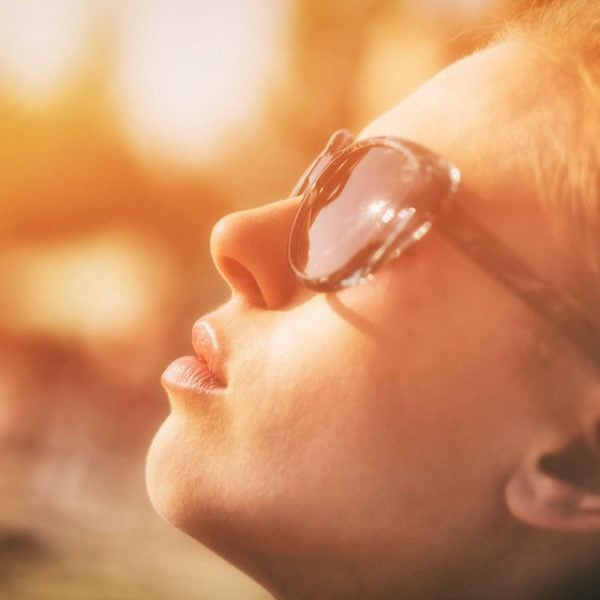There’s been increasing talk about how blue light from phones and computer screens could be a potential cause of skin damage. Is it worth worrying about, or is it just marketing? This topic is going to be a two-parter.
In this installment we’re going to talk about visible light damage, and how you can protect your skin; in part 2, we’ll talk about the amount of light that phones and computers produce.
Check out the video version of this post here!
Part 2 is located here: Will Blue Light from Computers and Phones Damage Your Skin?
All about light wavelengths
When we protect ourselves from sunlight, we mostly think of sunscreens and UV. High energy UV rays from the sun are the main environmental cause of aging skin, and in light-skinned people, this is by far the biggest cause of skin damage.
But UV isn’t the only type of light from the sun that can reach us on earth – the sun also produces longer, lower energy wavelengths of light in the visible (400-700 nm) and infrared (700 nm-1 mm) regions.
The energy from the sun that reaches the earth’s surface is around 3-7% UV, 44% visible light and 53% infrared (IR). UV causes disproportionately more damage because shorter wavelength means higher energy, so each photon (light particle) that hits your skin has more energy.
But newer research has been finding that the visible and infrared wavelengths can also cause skin damage too. Even though each particle has less energy, there’s a lot more of them, so it ends up being almost a “death by a thousand paper cuts” situation.
Shorter wavelengths of visible light that are closer to the UV range are the ones that have gotten the most attention, since they’re relatively more energetic and more damaging. In particular, it’s the wavelengths in the blue/purple region (400-500 nm) that have been found to be the most damaging. This shouldn’t really be surprising, since the divide between UV and visible light is pretty arbitrary, and is based on what our eyes can detect, not how our skin reacts.
Shorter wavelengths have higher energies, so blue and purple light is sometimes called high energy visible (HEV) light.
Related post: What Does SPF Mean? The Science of Sunscreen
What effects does visible light have on skin?
The research on blue light isn’t as advanced as the research on UV, so we don’t know anywhere near as much about how exactly it causes damage to skin.
And to make it more confusing, older studies on the effects of blue and violet light aren’t as valid. A lot of the time the lights used in the studies also produced UV, so it’s possible that the effects they found were from the contaminating UV rays and not the visible light at all – and even very small amounts of UVA1 (0.5%) can work synergistically with visible light in causing its effects.
The sort of skin damage that visible light causes is quite varied…
Different colours have different effects
Like with different parts of the spectrum, damage is all about wavelength within the visible spectrum. Different wavelengths of visible light can even have the opposite effects on the skin.
- In animal studies, blue light (430-510 nm) slowed down skin recovery after it was disturbed, whereas red light (550-670 nm) sped it up, compared with no light (green and white light didn’t do anything)
- In cultured human skin cells, red light and IR radiation (630-940 nm) had no effect, but large amounts of blue light (between 412 and 453 nm) caused cell death
- In human volunteers with moderately dark skin, blue light (415 nm) caused increased pigment, but red light (630 nm) didn’t have any effect
It’s possible that the different wavelengths of visible light could have effects that counteract each other as well.
So far it seems that blue-violet light is the most damaging, and can cause the production of nitric oxide (NO) free radicals. Free radicals are highly reactive substances with unpaired electrons that can react with substances in your skin and damage them, as I’ve discussed before. This damage causes cells to multiply less, collagen to break down and other microscopic changes, which could eventually lead to damaged-looking skin.
In people with darker skin, visible light can cause increased pigmentation, although this seems to happen in a way that doesn’t involve free radicals. This seems to be the only visible skin change caused by visible light so far though.
Related video: Video: My Routine for Fading Acne Marks (Post-Inflammatory Hyperpigmentation)
Visible light and UV have different effects
While both blue light and UV can cause skin damage, it’s important to note that they cause different types of skin damage.
- Visible light doesn’t seem to cause much direct DNA damage, while UV does.
- Visible light also doesn’t increase the levels of the inflammatory cytokines IL-8 and TNFα while UV does.
- Blue light doesn’t significantly change the levels of p53, the tumour suppressor protein, while UV does.
- Visible light causes far lower levels of radicals to form than UV in light-skinned (Fitzpatrick type II) people, and changed the levels of lipids were changed in different ways after exposure.
- While both UV and visible light can cause pigmentation in people with darker skin (Fitzpatrick types IV-VI), the pigment caused by visible light seems to last longer than pigment caused by UVA1. The colour of the pigment is also different, with UVA1-induced pigment looking greyish and turning brown over time, while visible light caused brownish pigment (and a bit of redness when larger amounts of light was used).
Related post: Chemical vs Physical Sunscreens: The Science (with video)
Visible and UV light require different doses
Even when the changes in the skin caused by UV and visible light overlap, it generally requires a lot more visible light to cause a similar change. Light energy is usually measured in these studies in joules per square centimetre (J/cm²).
In one in vitro study, there were greater changes in the level of free radicals (ROS), inflammatory cytokines (IL-1α) and collagen-degrading enzymes (MMP-1) with 6 J/cm² of UV light than with 180 J/cm² of visible light.
The amount of energy required to cause pigment changes in skin is also different. In one pigmentation experiment, 5 J/cm² of UVA1 caused the same amount of pigmentation as 40 J/cm² of visible light on volunteers with dark skin – in other words, 8 times as much visible light energy was required. In a different experiment, UV was found to be 25 times more efficient at causing pigmentation than visible light.
The smallest amount of visible light that caused pigmentation in all of the dark skinned volunteers in the same study was 40 J/cm². Since visible light from the sun hits the Earth’s surface at around 0.050 W/cm² in summer in Texas and 1 W is 1 J/second, this translates to around 15 minutes of sunlight.
Visible light has different effects on different skin
How much visible light will affect your skin also depends on your skin colour. Bad news if you have darker skin – none of the tested amounts of visible light in one study caused pigmentation in people with light Fitzpatrick II skin, but people with dark Fitzpatrick IV-VI skin had increased pigmentation. One theory is that visible light interacts with melanin to form reactive oxygen species, which is why darker skin is more sensitive to visible light.
How can I protect my skin from visible light?
So now that you’re scared of visible light, how do you protect yourself from it? Unfortunately, sunscreen isn’t the answer. To protect from visible light, you need a visible product, and even sunscreens that contain “physical blockers” zinc oxide and titanium dioxide can’t protect from visible light, even when you put on a really thick layer (and if you’ve been paying attention, you’ll also know that these sunscreen ingredients work along the same lines as organic sunscreen ingredients anyway).
Protective ingredients
There are some other ingredients for protecting from visible light instead:
Iron oxide seems to be effective at absorbing all wavelengths of visible light and luckily, iron oxide is skin-coloured! It’s the main pigment in foundations and tinted moisturisers, and products containing iron oxide have been found to protect from pigmentation and improve the fading of melasma when it’s being treated with hydroquinone. Unfortunately there isn’t a standard measure of how well a particular foundation absorbs visible light, so it’s guesswork for now.
Antioxidants can reduce the effects of visible light. One study used a mixture of feverfew and soy extracts with gamma tocopherol (a form of vitamin E) on human volunteers and found that the free radicals produced were decreased by half.
Avoidance
The fact that you can see visible light is also helpful. While UV levels don’t necessarily match the amount of visible sunshine, we can see exactly how much visible light is hitting our skin! That means that we can use non-skincare methods of protecting our skin from visible light more effectively than for protecting skin from UV. Staying in the shade, and wearing hats and protective clothing will prevent visible light from damaging your skin, and won’t require as much guesswork or reapplication as skincare products.
Verdict
Keep in mind that the research on visible light is still quite new, and the fact that it’s new should be reassuring. It’s taken this long to get around to researching it because UV causes the vast majority of damage. Visible light only causes a relatively small amount (and the only clinical effect so far is pigmentation in dark skin). We have lots of information already on how to protect ourselves from UV.
References
Liebel F et al, Irradiation of skin with visible light induces reactive oxygen species and matrix-degrading enzymes (open access), J Invest Dermatol 2012, 132, 1901-1907.
Mahmoud BH et al., Impact of long-wavelength UVA and visible light on melanocompetent skin (open access), J Invest Dermatol 2010, 130, 2092-2097.
Vandersee S et al., Blue-violet light irradiation dose dependently decreases carotenoids in human skin, which indicates the generation of free radicals (open access), Oxid Med Cell Longev 2015, 2015, 579675.











Love this pos! It answers the questions I had about visible light. But I thought mineral filters were better to protect against it as they work someway as a mirror, so that I guessed they also reflected at least some portion of visible light. Am I completely wrong?
It’s a common myth that physical filters reflect significantly, I talk about it in my sunscreen ingredients post: Chemical vs Physical Sunscreens: The Science (with video)
Dear Michelle, thank you for keeping up the good work. So informative!
Lucía
I noted that blue light is being used as acne treatment because it kills Propionibacterium acnes. Does this mean that using blue light to kill bacteria is actually a two-edged sword in that it kills the bacteria but also causes damage? I’ve also read a lot on red and green light therapy that are used to improve fine lines and pigmentation. These are questions are probably posts all by themselves! (hint) 🙂
I am have the exact same question!
Glad you cleared that up. Thanks!
Hi thanx for explaining it so clearly!
Can already uv damaged skin be helped with retinol and vitamin c? I did a test in a beauty studio the other day and they said I have lots of bacteria on my skin, no wrinkles but I have uv damaged skin and that I can’t do anything about it.. 🙁 is that a fact?
Yes! Vitamin A can definitely reverse skin photoaging – but tretinoin will likely work better.
Hey Michelle! Thanks for the informative post. Dr Dray in her video said that non nano (particle size greater than 200nm zinc oxide) sunscreens can protect against visible light. And tinted sunscreens with iron oxides at greater than 3% protected against visible light, but non tinted sunscreen topped with makeup containing iron oxides did not have a protective effect.
Can you clarify if this information is correct? Thanks 🙂
Do you have a link to the studies she cited for that? The 1991 Kaye study pretty convincingly shows that large particle zinc oxide doesn’t do much. There’s also some newer studies on what protects against visible light, and it keeps coming back to pigmentary TiO2 and iron oxides: https://labmuffin.com/how-to-protect-your-skin-against-blue-light-an-update-with-video/
Love your blog.
Regarding this paragraph, I think the final calculation is erroneous.
“The smallest amount of visible light that caused pigmentation in all of the dark skinned volunteers in the same study was 40 J/cm². Since visible light from the sun hits the Earth’s surface at around 0.050 W/cm² in summer in Texas and 1 W is 1 J/second, this translates to around 30 minutes of sunlight.”
Assuming “this” refers to “40 J/cm²,” when you divide this by 0.05 J/(cm²s), you get 800 s, which is ~13 minutes. Am I missing something?
I think I tried to estimate how much contribution would be from HEV, but I didn’t write out my reasoning in the post, and of course now I can’t remember what happened – thank you for picking it up!